Types of Pain in the Ankle
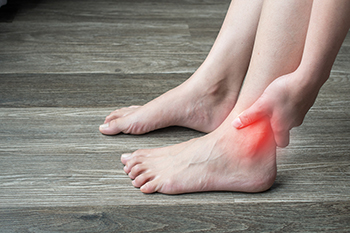
Ankle pain can be brought on by over-exercising or wearing shoes that do not fit properly. Such pain can also arise from a sprained ankle, Achilles tendonitis, or bursitis, among other things. Symptoms of a sprained ankle are usually pain, swelling, and bruising. Achilles tendonitis results from over-stretching of the Achilles tendon. Pain will often be felt in the ankle, heel, and possibly the calf, especially when standing on the tiptoes. Bursitis is when the fluid-filled sacs around the joints become inflamed. One might experience redness and swelling in the ankle, in addition to a dull aching pain. If you suffer from ankle pain and it is not improving with rest and cessation of activity, it is suggested that you see a podiatrist to help determine its cause and obtain a treatment plan.
Ankle pain can be caused by a number of problems and may be potentially serious. If you have ankle pain, consult with Dr. Joshua David Scoll from Pennsylvania. Our doctor will assess your condition and provide you with quality foot and ankle treatment.
Ankle pain is any condition that causes pain in the ankle. Due to the fact that the ankle consists of tendons, muscles, bones, and ligaments, ankle pain can come from a number of different conditions.
Causes
The most common causes of ankle pain include:
- Types of arthritis (rheumatoid, osteoarthritis, and gout)
- Ankle sprains
- Broken ankles
- Achilles tendinitis
- Achilles tendon rupture
- Stress fractures
- Bursitis
- Tarsal tunnel syndrome
- Plantar fasciitis
Symptoms
Symptoms of ankle injury vary based upon the condition. Pain may include general pain and discomfort, swelling, aching, redness, bruising, burning or stabbing sensations, and/or loss of sensation.
Diagnosis
Due to the wide variety of potential causes of ankle pain, podiatrists will utilize a number of different methods to properly diagnose ankle pain. This can include asking for personal and family medical histories and of any recent injuries. Further diagnosis may include sensation tests, a physical examination, and potentially x-rays or other imaging tests.
Treatment
Just as the range of causes varies widely, so do treatments. Some more common treatments are rest, ice packs, keeping pressure off the foot, orthotics and braces, medication for inflammation and pain, and surgery.
If you have any questions, please feel free to contact one of our offices located in Philadelphia, Bensalem, and Fairless Hills, PA . We offer the newest diagnostic and treatment technologies for all your foot care needs.
Toenail Fungus Can Cause Nail Damage

Toenail fungus can be unsightly. People who are afflicted with this condition are often embarrassed and may hide their feet. It is caused by a fungus that can penetrate the nail bed. Common symptoms can begin with noticing a white spot under the nail, and the nail may progress to becoming thick and brittle. If left untreated, the nail may fall off, and a new nail will grow, often with the same fungus. The fungus that causes this foot condition lives and thrives in warm and moist environments. These can include shower room floors, public swimming pools, and locker rooms. It is considered to be contagious, and its spread may be controlled by wearing appropriate footwear, such as water shoes or flip-flops. The majority of toenail fungus is treatable, and if you have this condition, it is suggested that you confer with a podiatrist who can offer correct treatment options, which may include prescribed medicine.
If left untreated, toenail fungus may spread to other toenails, skin, or even fingernails. If you suspect you have toenail fungus it is important to seek treatment right away. For more information about treatment, contact Dr. Joshua David Scoll of Pennsylvania. Our doctor can provide the care you need to keep you pain-free and on your feet.
Symptoms
- Warped or oddly shaped nails
- Yellowish nails
- Loose/separated nail
- Buildup of bits and pieces of nail fragments under the nail
- Brittle, broken, thickened nail
Treatment
If self-care strategies and over-the-counter medications does not help your fungus, your podiatrist may give you a prescription drug instead. Even if you find relief from your toenail fungus symptoms, you may experience a repeat infection in the future.
Prevention
In order to prevent getting toenail fungus in the future, you should always make sure to wash your feet with soap and water. After washing, it is important to dry your feet thoroughly especially in between the toes. When trimming your toenails, be sure to trim straight across instead of in a rounded shape. It is crucial not to cover up discolored nails with nail polish because that will prevent your nail from being able to “breathe”.
In some cases, surgical procedure may be needed to remove the toenail fungus. Consult with your podiatrist about the best treatment options for your case of toenail fungus.
If you have any questions, please feel free to contact one of our offices located in Philadelphia, Bensalem, and Fairless Hills, PA . We offer the newest diagnostic and treatment technologies for all your foot care needs.
Wearing High Heels May Hurt Your Feet
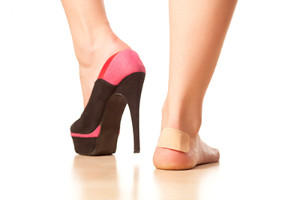
Research has shown that frequently wearing high heels can potentially damage the feet. Chronic foot pain may often accompany this, and alternating with flat shoes may help to reduce this. Despite this, there are some women who will continue to wear high heels. There may be mild relief that is found while wearing these types of shoes by taping the third and fourth toes together. Women who have tried this report it is extremely uncomfortable, and it may affect balance. They have also found the end result is less pain while wearing high heels. There are some women who take mild pain relief medication, and this may help to reduce existing swelling from wearing heels for long periods of time. If you enjoy wearing these types of shoes, it is strongly suggested that you speak with a podiatrist who can discuss with you various styles of high heels that may be better for your feet.
High heels have a history of causing foot and ankle problems. If you have any concerns about your feet or ankles, contact Dr. Joshua David Scoll from Pennsylvania. Our doctor can provide the care you need to keep you pain-free and on your feet.
Effects of High Heels on the Feet
High heels are popular shoes among women because of their many styles and societal appeal. Despite this, high heels can still cause many health problems if worn too frequently.
Which Parts of My Body Will Be Affected by High Heels?
- Ankle Joints
- Achilles Tendon – May shorten and stiffen with prolonged wear
- Balls of the Feet
- Knees – Heels cause the knees to bend constantly, creating stress on them
- Back – They decrease the spine’s ability to absorb shock, which may lead to back pain. The vertebrae of the lower back may compress.
What Kinds of Foot Problems Can Develop from Wearing High Heels?
- Corns
- Calluses
- Hammertoe
- Bunions
- Morton’s Neuroma
- Plantar Fasciitis
How Can I Still Wear High Heels and Maintain Foot Health?
If you want to wear high heeled shoes, make sure that you are not wearing them every day, as this will help prevent long term physical problems. Try wearing thicker heels as opposed to stilettos to distribute weight more evenly across the feet. Always make sure you are wearing the proper shoes for the right occasion, such as sneakers for exercising. If you walk to work, try carrying your heels with you and changing into them once you arrive at work. Adding inserts to your heels can help cushion your feet and absorb shock. Full foot inserts or metatarsal pads are available.
If you have any questions please feel free to contact one of our offices located in Philadelphia, Bensalem, and Fairless Hills, PA . We offer the newest diagnostic and treatment technologies for all your foot and ankle needs.
Is It a Bunion or Sesamoiditis?
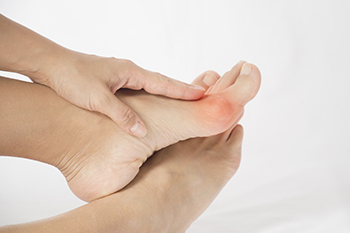
Bunions are a common affliction of the foot in which the bones in the feet are misaligned, resulting in a bony bulge at the base of the big toe. The underlying causes of bunion might be genetic or related to some kind of injury to the big toe. It is common for some individuals with bunions to possibly mistake their bunion for another condition of the foot, such as sesamoiditis. However, the two conditions are importantly different. Although both bunions and sesamoiditis can affect the big toe, sesamoiditis is characterized by the inflammation of the two sesamoid bones that float below the big toe joint. This inflammation can occur as a result of overuse. Bunions, by contrast, are primarily characterized by the bony bulge at the sides of the big toes. If you are someone who believes that they may have bunions or a related condition, it is suggested that you contact a podiatrist to make an appointment.
If you are suffering from bunions, contact Dr. Joshua David Scoll of Pennsylvania. Our doctor can provide the care you need to keep you pain-free and on your feet.
What Is a Bunion?
A bunion is formed of swollen tissue or an enlargement of boney growth, usually located at the base joint of the toe that connects to the foot. The swelling occurs due to the bones in the big toe shifting inward, which impacts the other toes of the foot. This causes the area around the base of the big toe to become inflamed and painful.
Why Do Bunions Form?
Genetics – Susceptibility to bunions are often hereditary
Stress on the feet – Poorly fitted and uncomfortable footwear that places stress on feet, such as heels, can worsen existing bunions
How Are Bunions Diagnosed?
Doctors often perform two tests – blood tests and x-rays – when trying to diagnose bunions, especially in the early stages of development. Blood tests help determine if the foot pain is being caused by something else, such as arthritis, while x-rays provide a clear picture of your bone structure to your doctor.
How Are Bunions Treated?
- Refrain from wearing heels or similar shoes that cause discomfort
- Select wider shoes that can provide more comfort and reduce pain
- Anti-inflammatory and pain management drugs
- Orthotics or foot inserts
- Surgery
If you have any questions, please feel free to contact one of our offices located in Philadelphia, Bensalem, and Fairless Hills, PA . We offer the newest diagnostic and treatment technologies for all your foot care needs.
Choosing Walking Shoes for Your Baby
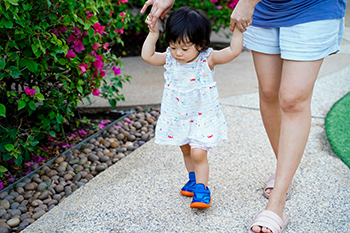
Until your baby begins to walk, it is thought by experts not to bother with shoes. Babies learn how to navigate, picking up information on balance and stability, while barefoot. It’s important to note that a baby’s feet develop over a period of time, and finding shoes that fit them is paramount to this process. The wise parent is one who frequently measures their baby’s feet over the first few years and replaces shoes as needed. A properly fitting shoe should have about half an inch between the toe and the tip of the shoe. It should also have enough room in the toe box for your toddler to wiggle their feet. Watch for a loose or slipping heel when they walk and any red marks on their feet when the shoes are removed. Lightweight materials such as leather or mesh are thought to be best for a baby’s development. Velcro straps and washability are also positive features. For more information on the best shoes for your toddler, it is a good idea to consult a podiatrist.
The health of a child’s feet is vital to their overall well-being. If you have any questions regarding foot health, contact Dr. Joshua David Scoll of Pennsylvania. Our doctor can provide the care you need to keep you pain-free and on your feet.
Tips for Keeping Children's Feet Healthy
- Make sure their shoes fit properly
- Look for any signs of in-toeing or out-toeing
- Check to see if they have Clubfoot (condition that affects your child’s foot and ankle, twisting the heel and toes inward) which is one of the most common nonmajor birth defects.
- Lightly cover your baby’s feet (Tight covers may keep your baby from moving their feet freely, and could prevent normal development)
- Allow your toddler to go shoeless (Shoes can be restricting for a young child’s foot)
- Cut toenails straight across to avoid ingrown toenails
- Keep your child’s foot clean and dry
- Cover cuts and scrapes. Wash any scratches with soap and water and cover them with a bandage until they’ve healed.
If you have any questions, please feel free to contact one of our offices located in Philadelphia, Bensalem, and Fairless Hills, PA . We offer the newest diagnostic and treatment technologies for all your foot care needs.
Plantar Fasciitis and Pickleball

Pickleball is a sporting activity that dates back 50 years. It can be compared to tennis and badminton, and the feet can often become injured. Plantar fasciitis is an injury that commonly affects pickleball players. It is defined as an inflammation of the plantar fascia, which is found on the sole of the foot. It connects the heel to the toes, and can become inflamed from straining, which can happen from overuse. This sport is played on outdoor asphalt surfaces, and can be extremely demanding on the feet. Many people enjoy playing pickleball for several hours in a row, and may find they are limping off of the court. Effective prevention methods can include wearing shoes that fit correctly, and limiting the play time for this sport. Having an abnormal foot structure, such as flat feet or high arches, may contribute to developing plantar fasciitis. People who enjoy playing pickleball that have these existing foot conditions may benefit from wearing custom-made orthotics. If you would like to have more information about how to protect your feet while playing pickleball, it is suggested that you confer with a podiatrist who can offer you additional prevention methods.
Plantar fasciitis can be very painful and inconvenient. If you are experiencing heel pain or symptoms of plantar fasciitis, contact Dr. Joshua David Scoll from Pennsylvania. Our doctor can provide the care you need to keep you pain-free and on your feet.
What Is Plantar Fasciitis?
Plantar fasciitis is the inflammation of the thick band of tissue that runs along the bottom of your foot, known as the plantar fascia, and causes mild to severe heel pain.
What Causes Plantar Fasciitis?
- Excessive running
- Non-supportive shoes
- Overpronation
- Repeated stretching and tearing of the plantar fascia
How Can It Be Treated?
- Conservative measures – anti-inflammatories, ice packs, stretching exercises, physical therapy, orthotic devices
- Shockwave therapy – sound waves are sent to the affected area to facilitate healing and are usually used for chronic cases of plantar fasciitis
- Surgery – usually only used as a last resort when all else fails. The plantar fascia can be surgically detached from the heel
While very treatable, plantar fasciitis is definitely not something that should be ignored. Especially in severe cases, speaking to your doctor right away is highly recommended to avoid complications and severe heel pain. Your podiatrist can work with you to provide the appropriate treatment options tailored to your condition.
If you have any questions please feel free to contact one of our offices located in Philadelphia, Bensalem, and Fairless Hills, PA . We offer the newest diagnostic and treatment technologies for all your foot and ankle needs.
Causes of Pain in the Ball of the Foot
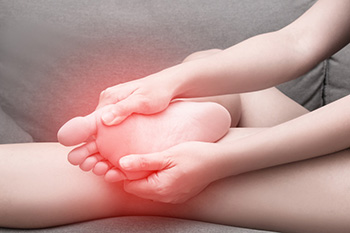
The metatarsals are the five long bones beneath the toes of the foot, also known as the midfoot. When the area between the toes and the metatarsals becomes painful, it is a condition termed metatarsalgia. Symptoms are inflammation, bruising and swelling. These in turn may result in numbness and tingling in the toes. Pain is typically felt in the ball of the foot. Better cushioning in the shoes and resting the feet more are some ways to reduce the pain. Causes of metatarsalgia include distance running and engaging in sports such as tennis, soccer, football, and baseball. Wearing poorly fitted shoes is another major cause of metatarsalgia. Culprits include high heels, shoes with a narrow toe box and sports shoes that lack ample cushioning. These types of shoes typically force the weight forward in a way that the ball of the foot is impacted. Other causes of metatarsalgia include bunions, hammertoes, and high arches, all of which can tend to alter proper foot alignment and gait. If the ball of your foot is aching on a regular basis, please consult a podiatrist for information on treatment options.
Foot Pain
Foot pain can be extremely painful and debilitating. If you have a foot pain, consult with Dr. Joshua David Scoll from Pennsylvania. Our doctor will assess your condition and provide you with quality foot and ankle treatment.
Causes
Foot pain is a very broad condition that could be caused by one or more ailments. The most common include:
- Bunions
- Hammertoes
- Plantar Fasciitis
- Bone Spurs
- Corns
- Tarsal Tunnel Syndrome
- Ingrown Toenails
- Arthritis (such as Gout, Rheumatoid, and Osteoarthritis)
- Flat Feet
- Injury (from stress fractures, broken toe, foot, ankle, Achilles tendon ruptures, and sprains)
- And more
Diagnosis
To figure out the cause of foot pain, podiatrists utilize several different methods. This can range from simple visual inspections and sensation tests to X-rays and MRI scans. Prior medical history, family medical history, and any recent physical traumatic events will all be taken into consideration for a proper diagnosis.
Treatment
Treatment depends upon the cause of the foot pain. Whether it is resting, staying off the foot, or having surgery; podiatrists have a number of treatment options available for foot pain.
If you have any questions, please feel free to contact one of our offices located in Philadelphia, Bensalem, and Fairless Hills, PA . We offer the newest diagnostic and treatment technologies for all your foot care needs.
Various Reasons for Toe Pain

There are several reasons why people may experience toe pain. These can include having a broken toe, an ingrown toenail, or the painful foot condition that is known as gout. Nerve pain can develop from having tarsal tunnel syndrome, which can lead to toe pain. Pain that affects the nerve between the third and fourth toes may come from having Morton’s neuroma, which generally develops from frequently wearing high heels. Another painful foot condition is known as tennis toe, and is quite unsightly. This condition causes blood to pool under the toenail, and happens from constantly jamming the toe against the top of the shoe. The nail will turn a red and black color, and prompt medical attention is required to prevent toe joint pain. If you have toe pain for any reason, it is strongly urged that you speak with a podiatrist who can determine what the cause is, and treat it accordingly.
Toe pain can disrupt your daily activities. If you have any concerns, contact Dr. Joshua David Scoll of Pennsylvania. Our doctor can provide the care you need to keep you pain-free and on your feet.
What Causes Toe Pain?
Most severe toe pain is caused due to a sports injury, trauma from dropping something heavy on the toe, or bumping into something rigid. Other problems can develop over time for various reasons.
Toe pain can be caused by one or more ailments. The most common include:
- Trauma
- Sports injury
- Wearing shoes that are too tight
- Arthritis
- Gout
- Corns and calluses
- Hammertoe
- Bunions
- Blisters
- Ingrown toenails
- Sprains
- Fractures (broken bones)
- Dislocations
When to See a Podiatrist
- Severe pain
- Persistent pain that lasts more than a week
- Signs of infection
- Continued swelling
- Pain that prevents walking
Diagnosis
In many cases the cause of toe pain is obvious, but in others, a podiatrist may want to use more advanced methods to determine the problem. These can range from simple visual inspections and sensation tests to X-rays and MRI scans. Prior medical history, family medical history, and any recent physical traumatic events will all be taken into consideration for a proper diagnosis.
Treatment
Treatments for toe pain and injuries vary and may include shoe inserts, padding, taping, medicines, injections, and in some cases, surgery. If you believe that you have broken a toe, please see a podiatrist as soon as possible.
If you have any questions please feel free to contact one of our offices located in Philadelphia, Bensalem, and Fairless Hills, PA . We offer the newest diagnostic tools and technology to treat your foot and ankle needs.
Foot Exercises Can Help Prevent Running Injuries
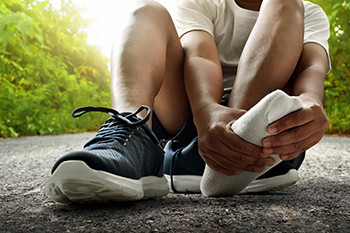
Research has shown that keeping the feet strong is the best way to reduce the chances of running injuries. Doing foot strengthening exercises can not only improve the health of your feet, it can also improve the effects that running can have on the rest of the body. The main objective of this type of exercise is to strengthen the arch and reduce pronation. One such exercise is called the short foot exercise. Start by sitting in a chair with one bare foot placed flat on the floor. Contract the muscles in the foot in a way that pulls the toes toward the body. This increases the gap between the arch of the foot and the floor, in effect, shortening the foot. Try to keep your heels and your toes touching the floor. When the foot is shortened as much as possible, let go and relax the foot. Complete 10 repetitions before switching to the other foot. Another exercise is to stand on the ball of one foot for 10 seconds, then alternate feet. Continue this process for 10 minutes. For more information on how to strengthen your feet, please consult a podiatrist.
Exercising your feet regularly with the proper foot wear is a great way to prevent injuries. If you have any concerns about your feet, contact Dr. Joshua David Scoll of Pennsylvania. Our doctor will treat your foot and ankle needs.
How to Prevent Running Injuries
Many common running injuries are caused by overuse and overtraining. When the back of the kneecap starts wearing out and starts causing pain in your knee, this is commonly referred to as runner’s knee. Runner’s knee is a decrease in strength in your quadriceps and can occur if you’re not wearing properly fitted or supporting shoes. To prevent runner’s knee, focusing on hip strengthening is a good idea, as well as strengthening your quads to keep the kneecaps aligned.
What Are Some Causes of Running Injuries?
- One cause of a common running injury is called iliotibial band syndrome.
- Plantar fasciitis is also another common injury.
- Stress fractures can occur from overtraining, lack of calcium, or even your running style.
Best Ways to Prevent Running Injuries
- Wear footwear that fits properly and suits your running needs.
- Running shoes are the only protective gear that runners have to safeguard them from injury.
- Make a training schedule. Adding strengthening exercises as well as regular stretching can help keep you strong and limber and can lessen the possibility of injuries.
- Stretching keeps muscles limber; this will help you gain better flexibility.
If you have any questions please feel free to contact one of our offices located in Philadelphia, Bensalem, and Fairless Hills, PA . We offer the newest diagnostic and treatment technologies for all your foot and ankle needs.
Bunions and Foot Baths
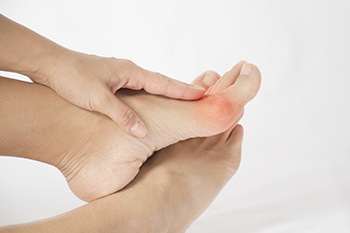
Bunions are a bony kind of bump that can develop on the outer side of the big toe or the pinky toe. Bunions have the potential to cause the individual a significant amount of discomfort. Bunions are typically something that patients will want to treat, and there are many ways in which one might go about treating their bunions. For example, an individual with bunions might choose to use the power of foot baths. Sometimes, individuals suffering from bunions can experience some kind of stiffness in their big toes due to the bunion. Immersing the feet in a warm foot bath can significantly help to mitigate feelings of stiffness. If a warm bath for the feet is not possible, then one might substitute a warm foot bath with a steamed towel. It usually helps if the towel is moist as well. If you are suffering from bunions, contact a podiatrist today for an appointment.
If you are suffering from bunions, contact Dr. Joshua David Scoll of Pennsylvania. Our doctor can provide the care you need to keep you pain-free and on your feet.
What Is a Bunion?
A bunion is formed of swollen tissue or an enlargement of boney growth, usually located at the base joint of the toe that connects to the foot. The swelling occurs due to the bones in the big toe shifting inward, which impacts the other toes of the foot. This causes the area around the base of the big toe to become inflamed and painful.
Why Do Bunions Form?
Genetics – Susceptibility to bunions are often hereditary
Stress on the feet – Poorly fitted and uncomfortable footwear that places stress on feet, such as heels, can worsen existing bunions
How Are Bunions Diagnosed?
Doctors often perform two tests – blood tests and x-rays – when trying to diagnose bunions, especially in the early stages of development. Blood tests help determine if the foot pain is being caused by something else, such as arthritis, while x-rays provide a clear picture of your bone structure to your doctor.
How Are Bunions Treated?
- Refrain from wearing heels or similar shoes that cause discomfort
- Select wider shoes that can provide more comfort and reduce pain
- Anti-inflammatory and pain management drugs
- Orthotics or foot inserts
- Surgery
If you have any questions, please feel free to contact one of our offices located in Philadelphia, Bensalem, and Fairless Hills, PA . We offer the newest diagnostic and treatment technologies for all your foot care needs.
Toenail Fungus and Athlete’s Foot

Athlete’s foot can certainly cause toenail fungus. While athlete’s foot can seem like a minor skin ailment, it can lead to more challenging complications if it affects toenails. Athlete’s foot is a fungus that grows on the soles of the feet and in between the toes. It can cause the skin on the feet to crack, peel, and become flaky. Sometimes it will become red and itch and there will be burning and stinging sensations. Toenail fungus grows under the nails and lives off skin and keratin. This erodes the protein in the nails causing them to turn dark yellow. The nails can also become brittle, push away from the nail bed, and emit an unpleasant odor. If athlete’s foot is not treated early, it can spread to the toenails. Given that either of these things can turn into a more severe infection, particularly among diabetics and those with other health conditions, it is a good idea to see a podiatrist for treatment at the first sign of a fungal infection.
For more information about treatment, contact Dr. Joshua David Scoll of Pennsylvania. Our doctor can provide the care you need to keep you pain-free and on your feet.
Toenail Fungus Treatment
Toenail fungus is a condition that affects many people and can be especially hard to get rid of. Fortunately, there are several methods to go about treating and avoiding it.
Antifungals & Deterrence
Oral antifungal medicine has been shown to be effective in many cases. It is important to consult with a podiatrist to determine the proper regiment for you, or potentially explore other options.
Applying foot powder on the feet and shoes helps keep the feet free of moisture and sweat.
Sandals or open toed shoes – Wearing these will allow air movement and help keep feet dry. They also expose your feet to light, which fungus cannot tolerate. Socks with moisture wicking material also help as well.
If you have any questions please feel free to contact one of our offices located in Philadelphia, Bensalem, and Fairless Hills, PA . We offer the newest diagnostic tools and technology to treat your foot and ankle needs.
A Broken Foot May Be a Common Injury Among Children
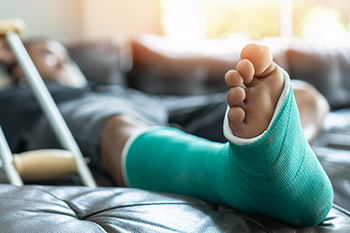
A broken foot is a common injury that can occur in children. The majority of children spend their day running, jumping, and falling, and in most cases, the bones have adequate flexibility and strength that may help to avoid fracturing a foot. For the rare occasions that a child breaks their foot, it is beneficial to know that the healing time is often accelerated as a result of their age. One of the most common reasons a child may break their foot is from falling. There are noticeable symptoms of this, including severe pain, numbness, and the inability to walk. Once a proper diagnosis is obtained, the correct treatment can begin.This generally involves putting the broken foot in a cast or walking boot, which is typically adequate in providing the necessary stability as the healing process occurs. If your child has broken their foot, please consult with a podiatrist as quickly as possible who can help advise you of proper treatment, so your child can resume normal activities.
A broken foot requires immediate medical attention and treatment. If you need your feet checked, contact Dr. Joshua David Scoll from Pennsylvania. Our doctor can provide the care you need to keep you pain-free and on your feet.
Broken Foot Causes, Symptoms, and Treatment
A broken foot is caused by one of the bones in the foot typically breaking when bended, crushed, or stretched beyond its natural capabilities. Usually the location of the fracture indicates how the break occurred, whether it was through an object, fall, or any other type of injury.
Common Symptoms of Broken Feet:
- Bruising
- Pain
- Redness
- Swelling
- Blue in color
- Numbness
- Cold
- Misshapen
- Cuts
- Deformities
Those that suspect they have a broken foot shoot seek urgent medical attention where a medical professional could diagnose the severity.
Treatment for broken bones varies depending on the cause, severity and location. Some will require the use of splints, casts or crutches while others could even involve surgery to repair the broken bones. Personal care includes the use of ice and keeping the foot stabilized and elevated.
If you have any questions please feel free to contact one of our offices located in Philadelphia, Bensalem, and Fairless Hills, PA . We offer the newest diagnostic and treatment technologies for all your foot and ankle needs.
More...
Blisters and Hiking

Any hiker knows that hiking with blisters on the feet can be a significant annoyance and source of potential pain. Blisters can develop on the feet for many different reasons (typically due to some kind of pressure that is applied to an area of the feet). Blisters can be especially pernicious to hikers. Blisters are the most common foot affliction among hikers. Since hiking requires a significant amount of physical movement including walking and climbing, blisters can diminish the hiking experience. There are several things that hikers might consider doing to prevent blisters from forming in the first place. For example, hikers might consider getting hiking boots that fit correctly and do not rub up against the feet in uncomfortable ways. Hikers can also be on the lookout for the other main causes of blister formation: heat and moisture. Hikers can also be mindful about wearing thin socks to prevent the blisters from forming in the first place. Contact a podiatrist today if you are a hiker concerned about preventing foot blisters.
Blisters are prone to making everyday activities extremely uncomfortable. If your feet are hurting, contact Dr. Joshua David Scoll of Pennsylvania. Our doctor can provide the care you need to keep you pain-free and on your feet.
Foot Blisters
Foot blisters develop as a result of constantly wearing tight or ill-fitting footwear. This happens due to the constant rubbing from the shoe, which can often lead to pain.
What Are Foot Blisters?
A foot blister is a small fluid-filled pocket that forms on the upper-most layer of the skin. Blisters are filled with clear fluid and can lead to blood drainage or pus if the area becomes infected.
How Do Blisters Form?
Blisters on the feet are often the result of constant friction of skin and material, usually by shoe rubbing. Walking in sandals, boots, or shoes that don’t fit properly for long periods of time can result in a blister. Having consistent foot moisture and humidity can easily lead to blister formation.
Prevention & Treatment
It is important to properly care for the affected area in order to prevent infection and ease the pain. Do not lance the blister and use a Band-Aid to provide pain relief. Also, be sure to keep your feet dry and wear proper fitting shoes. If you see blood or pus in a blister, seek assistance from a podiatrist.
If you have any questions, please feel free to contact one of our offices located in Philadelphia, Bensalem, and Fairless Hills, PA . We offer the newest diagnostic and treatment technologies for all your foot care needs.
Symptoms of Athlete’s Foot
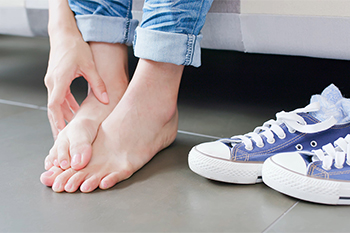
Athlete's foot can be uncomfortable. It is a foot condition that causes the skin on the feet to itch and become red, and in severe cases, may cause small blisters. It is caused by a fungus called trichophyton and is found in warm and moist environments. These include public swimming pools, locker rooms, and shower room floors. Research has shown it is a common foot ailment, and approximately 70 percent of people worldwide will be infected at some point during their lives. The common symptoms that are associated with athletes’ foot consist of flaking skin and burning between the toes. Athlete’s foot is contagious, and many cases may be prevented by wearing appropriate shoes while in these types of areas. Water shoes and flip flops fall into this category, and wearing these types of shoes may help to reduce the chances of getting athlete's foot. If you or someone you know has this infection, please consult with a podiatrist who can offer you prescribed medication that can cure this ailment.
Athlete’s Foot
Athlete’s foot is often an uncomfortable condition to experience. Thankfully, podiatrists specialize in treating athlete’s foot and offer the best treatment options. If you have any questions about athlete’s foot, consult with Dr. Joshua David Scoll from Pennsylvania. Our doctor will assess your condition and provide you with quality treatment.
What Is Athlete’s Foot?
Tinea pedis, more commonly known as athlete’s foot, is a non-serious and common fungal infection of the foot. Athlete’s foot is contagious and can be contracted by touching someone who has it or infected surfaces. The most common places contaminated by it are public showers, locker rooms, and swimming pools. Once contracted, it grows on feet that are left inside moist, dark, and warm shoes and socks.
Prevention
The most effective ways to prevent athlete’s foot include:
- Thoroughly washing and drying feet
- Avoid going barefoot in locker rooms and public showers
- Using shower shoes in public showers
- Wearing socks that allow the feet to breathe
- Changing socks and shoes frequently if you sweat a lot
Symptoms
Athlete’s foot initially occurs as a rash between the toes. However, if left undiagnosed, it can spread to the sides and bottom of the feet, toenails, and if touched by hand, the hands themselves. Symptoms include:
- Redness
- Burning
- Itching
- Scaly and peeling skin
Diagnosis and Treatment
Diagnosis is quick and easy. Skin samples will be taken and either viewed under a microscope or sent to a lab for testing. Sometimes, a podiatrist can diagnose it based on simply looking at it. Once confirmed, treatment options include oral and topical antifungal medications.
If you have any questions, please feel free to contact one of our offices located in Philadelphia, Bensalem, and Fairless Hills, PA . We offer the newest diagnostic and treatment technologies for all your foot care needs.
Gout Is Caused by Genetic Reasons or From Specific Foods
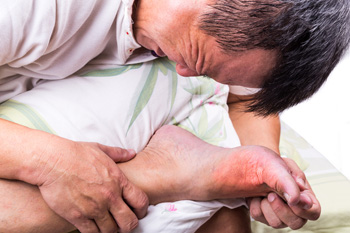
People who have endured gout attacks cannot ignore the pain that often accompanies this foot condition. Gout is a form of inflammatory arthritis and generally develops in the joints of the big toe. It happens as a result of excess uric acid in the blood, which may come from genetic reasons, or from eating foods with large amounts of purines. These types of foods can include shellfish, red meat, or drinks that are made with large amounts of sugar. This can cause uric acid crystals to form, often beginning in the big toe. People who have endured gout attacks for several years may develop tophi, which are uric acid deposits resembling small lumps under the skin of the affected toe. Gout may eventually resolve naturally. Many people choose to contact a podiatrist who can perform an effective diagnosis and offer treatment methods that are right for you. Additionally, this type of doctor is helpful in explaining how gout attacks can be prevented by implementing simple lifestyle changes.
Gout is a foot condition that requires certain treatment and care. If you are seeking treatment, contact Dr. Joshua David Scoll from Pennsylvania. Our doctor will treat your foot and ankle needs.
What Is Gout?
Gout is a type of arthritis caused by a buildup of uric acid in the bloodstream. It often develops in the foot, especially the big toe area, although it can manifest in other parts of the body as well. Gout can make walking and standing very painful and is especially common in diabetics and the obese.
People typically get gout because of a poor diet. Genetic predisposition is also a factor. The children of parents who have had gout frequently have a chance of developing it themselves.
Gout can easily be identified by redness and inflammation of the big toe and the surrounding areas of the foot. Other symptoms include extreme fatigue, joint pain, and running high fevers. Sometimes corticosteroid drugs can be prescribed to treat gout, but the best way to combat this disease is to get more exercise and eat a better diet.
If you have any questions please feel free to contact one of our offices located in Philadelphia, Bensalem, and Fairless Hills, PA . We offer the newest diagnostic and treatment technologies for all your foot and ankle needs.
Some Children May Be Prone to Plantar Warts
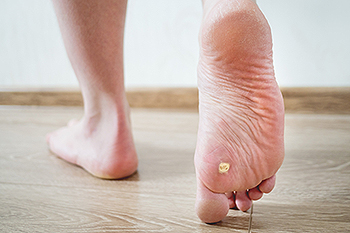
One ailment that can affect children is plantar warts. They are warts that develop on the bottom of the foot due to the pressure the foot endures while walking or running. These types of warts can cause extreme pain and discomfort and may disrupt the ability to run and play. Children may tell their parents that they feel like they are stepping on a small stone and the wart may have the appearance of a cauliflower with black veins in the center. These warts are contagious and the fungus that causes them lives in specific environments. These can include public swimming pools, locker rooms, and shower room floors so it is suggested that children wear appropriate shoes while in these areas. The fungus enters the body through small cracks on the skin and it is beneficial to refrain from sharing towels, shoes, and socks. Children with a weakened immune system may be susceptible to developing a plantar wart. This type of wart can be removed or treated by a podiatrist, so it is suggested that you schedule an appointment if your child is afflicted with this condition.
Plantar warts can be very uncomfortable. If you need your feet checked, contact Dr. Joshua David Scoll from Pennsylvania. Our doctor will assist you with all of your foot and ankle needs.
About Plantar Warts
Plantar warts are the result of HPV, or human papillomavirus, getting into open wounds on the feet. They are mostly found on the heels or balls of the feet.
While plantar warts are generally harmless, those experiencing excessive pain or those suffering from diabetes or a compromised immune system require immediate medical care. Plantar warts are easily diagnosed, usually through scraping off a bit of rough skin or by getting a biopsy.
Symptoms
- Lesions on the bottom of your feet, usually rough and grainy
- Hard or thick callused spots
- Wart seeds, which are small clotted blood vessels that look like little black spots
- Pain, discomfort, or tenderness of your feet when walking or standing
Treatment
- Freezing
- Electric tool removal
- Laser Treatment
- Topical Creams (prescription only)
- Over-the-counter medications
To help prevent developing plantar warts, avoid walking barefoot over abrasive surfaces that can cause cuts or wounds for HPV to get into. Avoiding direct contact with other warts, as well as not picking or rubbing existing warts, can help prevent the further spread of plantar warts. However, if you think you have developed plantar warts, speak to your podiatrist. He or she can diagnose the warts on your feet and recommend the appropriate treatment options.
If you have any questions please feel free to contact one of our offices located in Philadelphia, Bensalem, and Fairless Hills, PA . We offer the newest diagnostic and treatment technologies for all your foot and ankle needs.




